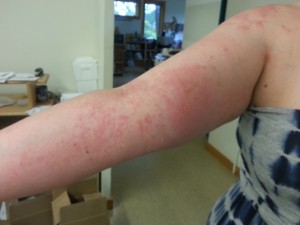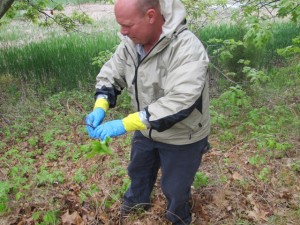“You’re gonna need an ocean
Of calamine lotion…”
Poison Ivy, The Drifters, 1959
There are two warnings we always give to sanctuary visitors: do regular tick checks and stay on the trails to avoid poison ivy.
Managing poison ivy requires constant vigilance during the growing season. The job of controlling it falls to our property manager, James Nielsen, who has shared some of his tips for avoiding the infamous rash that can result from coming in contact with an oil in the plant called urushiol.
James wears long pants, two pairs of gloves, seals the top of the gloves and his shirt sleeves with duct tape, then hopes for the best. When he’s done, clothes go right into the washer and shoes stay outside. Poison ivy oil can remain active for more than a year. James also recommends limiting removal to dry, mild days. Wet or hot weather, he says, can increase the chance of spreading oil to the skin.
Poison ivy can take on several different forms– a ground cover, a climbing vine or a shrub. The “leaves of three” adage is correct, but the warning about shiny leaves is not always true. And its color can change from spring to fall. There have also been studies that say PI may become more rampant and virulent with the increasing levels of carbon in the atmosphere.
On the plus side, poison ivy is a native plant that many animals eat without any adverse effects. Goats apparently even enjoy eating poison ivy although there is a risk of the animals passing the oil on to their caretakers just as pets can do if the oil gets on their fur.





